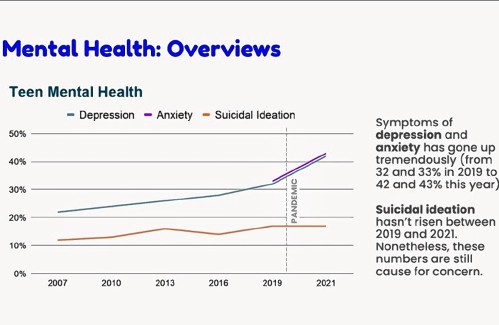GREENFIELD — Despite increased rates of depression and anxiety among area youth, data from the Communities That Care Coalition 2021 Teen Health Survey shows substance use has been declining dramatically among students during the COVID-19 pandemic.
During a Communities That Care Coalition meeting Friday afternoon, organizers shared the results of the 2021 Teen Health Survey.
Partnership for Youth Program Evaluator Sage Shea said the Communities That Care Coalition has been collecting this local data since 2003. Students in grades eight, 10 and 12 from nine school districts participate in the annual regional survey.
Participating districts include: Four Rivers Charter Public School, Franklin County Technical School, Greenfield and the Frontier, Gill-Montague, Mohawk Trail, Pioneer Valley, Ralph C. Mahar and Athol Royalston regional school districts. Despite being presented the option not to participate in the survey this year due to the pandemic, all nine schools still did participate in an online survey and submitted a total of 1,539 responses.
“Which shows us how much they really value the data that we provide each year,” Shea said.
Shea explained the survey questions touch on areas of mental health, substance use, ethnicity, gender and sexual orientation. While they typically rotate between three different surveys on teen health subjects, this year an abridged survey was created to include questions about students’ experiences during the COVID-19 quarantine.
One of the big takeaways from the survey’s results is that students are reporting high rates of depression, anxiety and loneliness. Girls are reportedly struggling more than boys, and mental health disparities are highest for queer students. Symptoms of depression and anxiety have increased from 32 and 33 percent in 2019 to 42 and 43 percent, respectively.
Depression and anxiety were reported in roughly twice as many students who identified outside of male or female genders, or as queer or questioning in sexual orientation, compared to straight or male or female identifying students. Similarly, rates of depression and anxiety were reportedly higher in students of color than white students.
Despite stress and anxiety increasing, substance use had been declining and dropped even more dramatically during the pandemic. Shea noted that the lack of social activity, and more time spent at home with parents, are factors that may have contributed to the sharp decline.
Alcohol use declined from roughly 35 percent in 2014 to about 23 percent in 2019 — dropping to 13 percent since the pandemic. Marijuana use fluctuated between 22 and 26 percent from 2014 to 2019, dropping to 14 percent since the pandemic. Students who reported vaping rose from less than 15 to over 30 percent between 2016 and 2019, but dropped as low as 11 percent from 2019 to today.
Shea noted that alcohol use among teenagers has been declining steadily over the last four years, and alcohol use among those who identify as other than male or female has dropped from 30 percent in 2019 to 7 percent today.
“So they might be incredibly stressed and incredibly anxious, but they’re not turning to drugs and alcohol to cope with that,” Shea said.
Of those who took the survey, roughly 47 percent were female, 48 percent male and 4 percent transgender or gender non-conforming. For sexual orientation, 79 percent identified as straight and 21 percent as queer. About 66 percent said they were “high socio-economic status” while 34 percent were “low socio-economic status.” Nearly 77 percent identified as white, 9 percent identified as Hispanic or Latino, 4 percent as Native American or Alaska Native, 3 percent as Asian and 5 percent as Black.
While suicidal ideation hasn’t increased since 2019, the steady level of about 18 percent is still cause for concern, Shea said. Data on suicidal ideation is important to consider in the context of access to lethal tools, a significant risk factor for the completion of suicide. Of those surveyed, 7 percent report “there is a gun in their home that they have access to.”
According to the survey, 20 percent of students said they were seeking help from friends, followed by 16 percent who said they were seeking help from parents and 15 percent from a therapist. Five percent said they sought a doctor, 4 percent school counselors and 3 percent teachers. While less than 10 percent said they turned to a school counselor or teacher for help in the past 12 months, Shea said 62 percent report they do have an adult in the school they feel they can talk to.
“That’s reassuring. It’s not that they don’t trust adults in the school system, but they find they feel supported by these groups,” Shea said.
Nearly 60 percent of respondents reported school being more stressful, and enjoying it less, than before the pandemic. Roughly 53 percent said they’ve been learning less this past year. However, nearly nine in ten students said their teachers are focused when teaching, and 86 percent don’t skip classes despite online learning making it easier to skip, Shea said.
More than half of students said they feel more lonely than before the pandemic. Not surprisingly, 60 percent also report spending less time with their friends. Video game and social media use is increasing, with half of students using their computers for non-school work more than four hours a day and sleeping less than six hours a night.
Another section of the survey, which related to racism and discrimination, asked students about experiences with micro-aggressions and representation of their race in and outside of the classroom. Between 10 and 38 percent more white students said “yes” compared to students of color when asked if they felt their race was positively portrayed in TV and movies, their culture and traditions were taught about, they read books with characters of their race or if they felt their race was fairly represented in what they learn.
Students of color also report notably higher rates of overt discrimination. Reports of wrongful discipline and detentions were largest between Black and white groups, 42 to 34 percent. Reports of police harassment were drastically different between racial groups, with 17 percent of Black students reporting police harassment. Native Americans report similar rates, while Asian and Pacific Island communities report no incidents of police harassment.
Full results of the 2021 Communities That Care Coalition Teen Health Survey can be found at bit.ly/3ykPAAD.
Zack DeLuca can be reached at zdeluca@recorder.com or 413-930-4579.

